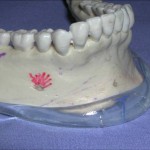Chin augmentation with the use of synthetic implants is a simple and very effective method to enhance the forward projection of the lower face. Placed through a small incision underneath the chin in a skin crease, the bone of the chin is easily accessed for implant positioning. While this concept for facial enhancement has been used for over 40 years and the operative technique has essentially remained the same, the shapes and sizes of chin implants however have changed dramatically.


The selection of chin implant style can be determined by a visual or photographic analysis of your chin and some computer imaging done to see what changes you consider helpful to your goals. The size of a chin implant, however, is best done by doing measurements on a good 1:1 photograph or a lateral cephalometric x-ray in a side view. Since the soft tissues of the chin move pretty much 1:1 on what the bone does underneath, one can fairly accurately predict what a certain thickness (size) of an implant will do in profile.
Changing the appearance of one’s chin today has more options than in the past. No longer do you have to just leave it up to the surgeon’s eye to determine what is best for you. As an Indianapolis chin surgeon, I prefer to use a combination of photographs and occasional x-rays to help plan the outcome of chin surgery. While even the best preoperative planning is no guarantee of results, the more thought and input you have from the patient beforehand, the more likely you will be achieve the patient’s goals.
Dr. Barry Eppley
Indianapolis, Indiana


